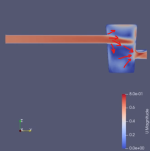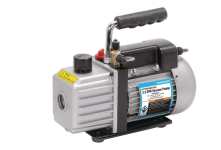Yes, it is low speed. For 10 years I had my Waterway Supreme. Always on low. It maintained a 98% full pot up until this season where it started to drop a little. I did some suction line inspection/repairs (pressure tested) as of late and it helped, but then I decided to install the new Power Flo Matrix I had laying around. New pump, valves, etc. I can post motor labels later, but the Matrix seems to be a slightly lower rated pump than the Waterway. Got me to wondering if it's able to sustain the pull of about 40' through approximately 10 elbows.
FYI - I took that 10 yr old Waterway last night and rigged it up next to the pool on the decking with a short in & out PVC line directly to/from the pool. Pump pot is 100% airtight and water full with not a spec of air in it. But to be fair, it's right next to the pool and no filter resistance.
Different pumps will act differently, even if the pump curves are identical.
My understanding is pool pumps are tested to a 2.4 m (8 feet) lift. This means they are placed in an elevated position (or equivalent), primed and tested. When I worked in this area a few years ago (probably 30) we used a mezzanine floor and a pond for testing.
However, as a rule of thumb, the vacuum gauge reading is added to the discharge gauge pressure to plot the pump performance. It may have changed, but this is how it was done at the place I worked.
I think it likely the new pump doesnt have as good an ability to create a vacuum as the previous pump, consequently the hair and lint is showing more air.
I'm experiencing some unusual air and in the past few months I have literally replaced just about everything (most of the line, pump, valves, etc) but the skimmer which I know has shifted (tilted) and has some stress cracks. My dye tests in static water we not conclusive. I've done some epoxy & silicone touch-up work inside the skimmer, but I am thinking I may have missed a spot. There wasn't anything that ever leaked water that I could tell. Nothing I could find when I had the skimmer exposed during my suction line repair in August, but I'm suspicious of that lower area in the skimmer. Since a pressure test only covers the line itself (skimmer hole to the pad), it got me to thinking about the lower half well area of the skimmer.
However, this post suggests the skimmer may have cracks etc in it from movement. It is possible under 'suction' the skimmer is opening up a little and sucking air. Never seen it, but could happen.
I think it would be worth doing an evaporation test in the skimmer.
Drop pool level just below skimmer weir.
Remove the basket.
Block the pipe(s) from the skimmer with an expanding test bung.
Fill the skimmer to a water level below the pool (dont want to measure entire pool loss). Mark it.
Float a plastic cup or similar two thirds full with water in the skimmer. Mark its water level.
Wait 24 hours.
Measure the difference in levels in the plastic cup and the skimmer. If they are the same then no leaks from skimmer itself.
It is important to use a plastic cup not polystyrene, it is important the cup floats in the skimmer it needs to be at same temperature as the water in the skimmer.
HTH






 While I have conducted several tests on my suction side since August, I plan on doing more inspections and tests this weekend. I'll post back a summary of everything once completed with those results and any specific details related to the pumps, plumbing, etc, to give a full pictures of my scenario.
While I have conducted several tests on my suction side since August, I plan on doing more inspections and tests this weekend. I'll post back a summary of everything once completed with those results and any specific details related to the pumps, plumbing, etc, to give a full pictures of my scenario.